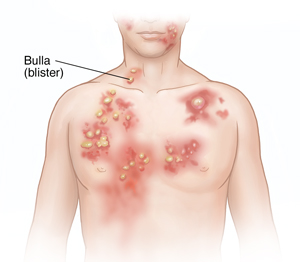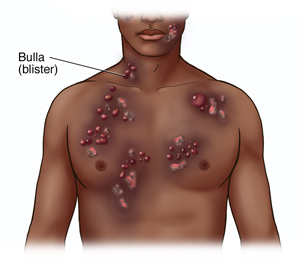Understanding Bullous Pemphigoid
Bullous pemphigoid is a rare autoimmune, chronic skin disease. It is more common in people ages 60 and older. It causes large blisters to form. These blisters may be on one part of the body or all over. They often appear on the arms, legs, groin, chest, and stomach. Sores may sometimes occur in the mouth, too.


How to say it
BUHL-uhs PEHM-fih-goyd
What causes bullous pemphigoid?
Bullous pemphigoid is an autoimmune disease. That’s when the immune system attacks healthy parts of the body. In this case, it attacks the proteins that join the skin cells to one another. The disease may also be caused by some medicines, such as penicillin.
Symptoms of bullous pemphigoid
Bullous pemphigoid may first look like hives or eczema, because it can be red and itchy. Large, firm blisters may then form. These blisters are often filled with a clear liquid. They may feel very itchy. The blisters may pop. But they usually don’t leave any scars. They may go away and come back again.
Treatment for bullous pemphigoid
The blisters from this skin disease may go away and come back. So treatment is often needed for a few years. Treatment options include:
-
Skin care. Using mild soap and anti-itch creams may help with symptoms.
-
Steroids. Steroids are the main treatment option for this disease. They may be creams or ointments that you put on your skin. Or they may be in pill or liquid form (oral). They can ease itching and stop new blisters from forming. Oral steroids may have side effects, so to prevent long-term complications, medicines that slow down the immune system may also be prescribed.
-
Antibiotics. You may need antibiotics to prevent or treat infection.
Possible complications of bullous pemphigoid
-
Skin infection
When to call your healthcare provider
Call your healthcare provider right away if you have any of these:
-
Fever of 100.4°F (38°C) or higher, or as directed by your provider
-
Pain that gets worse
-
Symptoms that don’t get better, or get worse
-
New symptoms